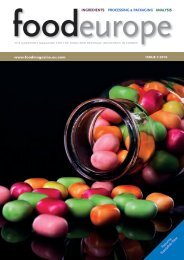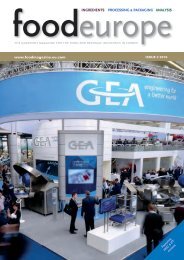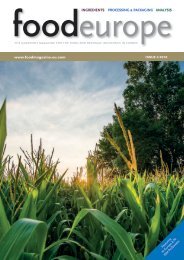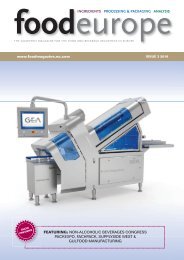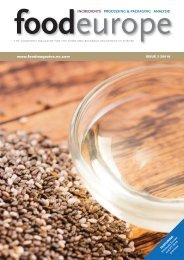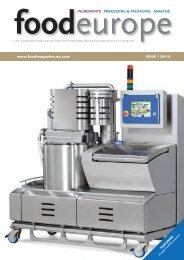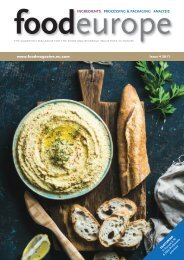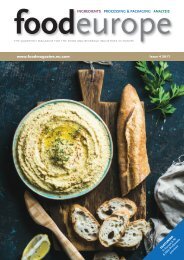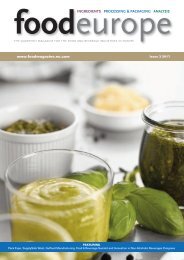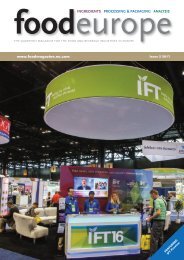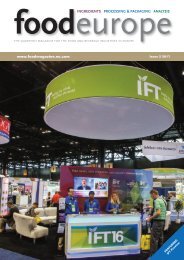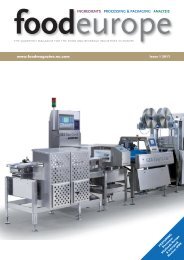issue 1 2017
Issue 1 2017 of FoodEurope Magazine
Issue 1 2017 of FoodEurope Magazine
Create successful ePaper yourself
Turn your PDF publications into a flip-book with our unique Google optimized e-Paper software.
processing & packaging 47<br />
Thermal Transfer Overprinting (TTO):<br />
An interview with Videojet<br />
In this Q&A, Drew Weightman, Global Business Unit Manager for Thermal Transfer Overprinters<br />
(TTO) at Videojet Technologies, looks at the challenges manufacturers face with regard to coding<br />
and marking onto flexible packaging and the areas in which TTO can help to improve efficiency and<br />
code quality<br />
Q: Have you identified any<br />
emerging trends with regard to<br />
flexible packaging formats?<br />
Flexible packaging is a dynamic<br />
space now with a couple of<br />
expanding trends. First, we see<br />
producers, particularly food<br />
producers, continuing to shift from<br />
rigid to flexible packaging formats,<br />
unlocking many of the cost and<br />
sustainability benefits that have<br />
become well known. However, we<br />
also see a shift within flexible<br />
packaging, as current users reveal<br />
some really exciting innovations<br />
beyond generic flexible wrapping.<br />
Innovations in shelf-ready flexible<br />
packaging such as stand up<br />
pouches are particularly<br />
interesting. Features such as clear<br />
windows that enable visibility<br />
directly to the contents inside, and<br />
seal strips that enable reclosure of<br />
the packaging for multi-use are<br />
just a couple of examples. These<br />
enhancements to flexible<br />
packaging are leading it to play the<br />
primary role for producers to meet<br />
accelerating consumer desires to<br />
identify with the origin and<br />
authenticity of their food choices.<br />
This enables the consumer to<br />
identify with the packaging in a<br />
way that they couldn’t in other<br />
formats - such as a rigid box. In<br />
rigid packaging, the product inside<br />
is hidden. A can for soup is a good<br />
example of this. There’s a real<br />
barrier between customer and<br />
product. The reason shelf ready<br />
flexible packaging is becoming<br />
more popular is that it enables<br />
customers to experience the<br />
products in a way that was not<br />
possible before – in terms of<br />
seeing the product, feeling the<br />
weight and interacting with it in<br />
general.<br />
The reasons to utilise flexible<br />
packaging are becoming widely<br />
recognised. However, many<br />
producers don’t realise that this<br />
shift opens new coding<br />
possibilities as well.<br />
Q: Is TTO the best technology to<br />
use for this form of packaging?<br />
As soon as you move from a rigid<br />
package to a flexible option, TTO<br />
becomes the natural choice for<br />
coding and marking. It’s by far the<br />
most reliable method for marking<br />
flexible packaging and brings a<br />
very high level of print quality. In<br />
many cases a brand owner has<br />
spent tremendous time and energy<br />
in creating a polished, authentic,<br />
shelf ready flexible package<br />
design. Placing a crude hot<br />
stamped code on that package<br />
would be contrary to all of that<br />
effort.<br />
TTO is also the obvious choice for<br />
production efficiency reasons. Old<br />
analogue technologies such as hot<br />
stamp or roller coders typically use<br />
metal stamps that may be held in a<br />
heated block. The type of these<br />
stamps needs to be manually<br />
www.foodmagazine.eu.com <strong>issue</strong> one | <strong>2017</strong>




